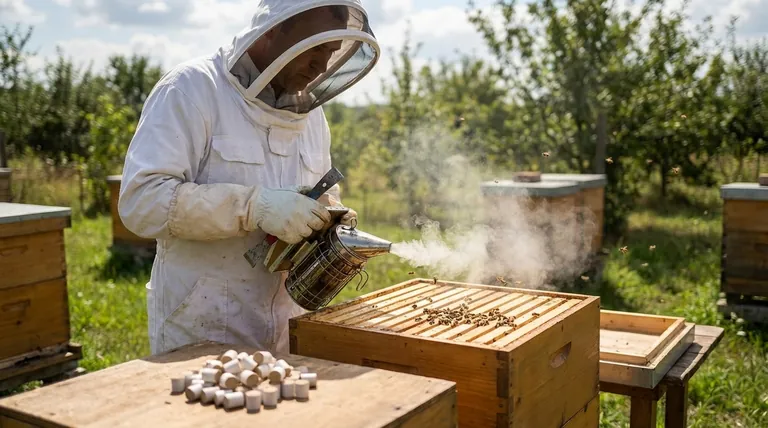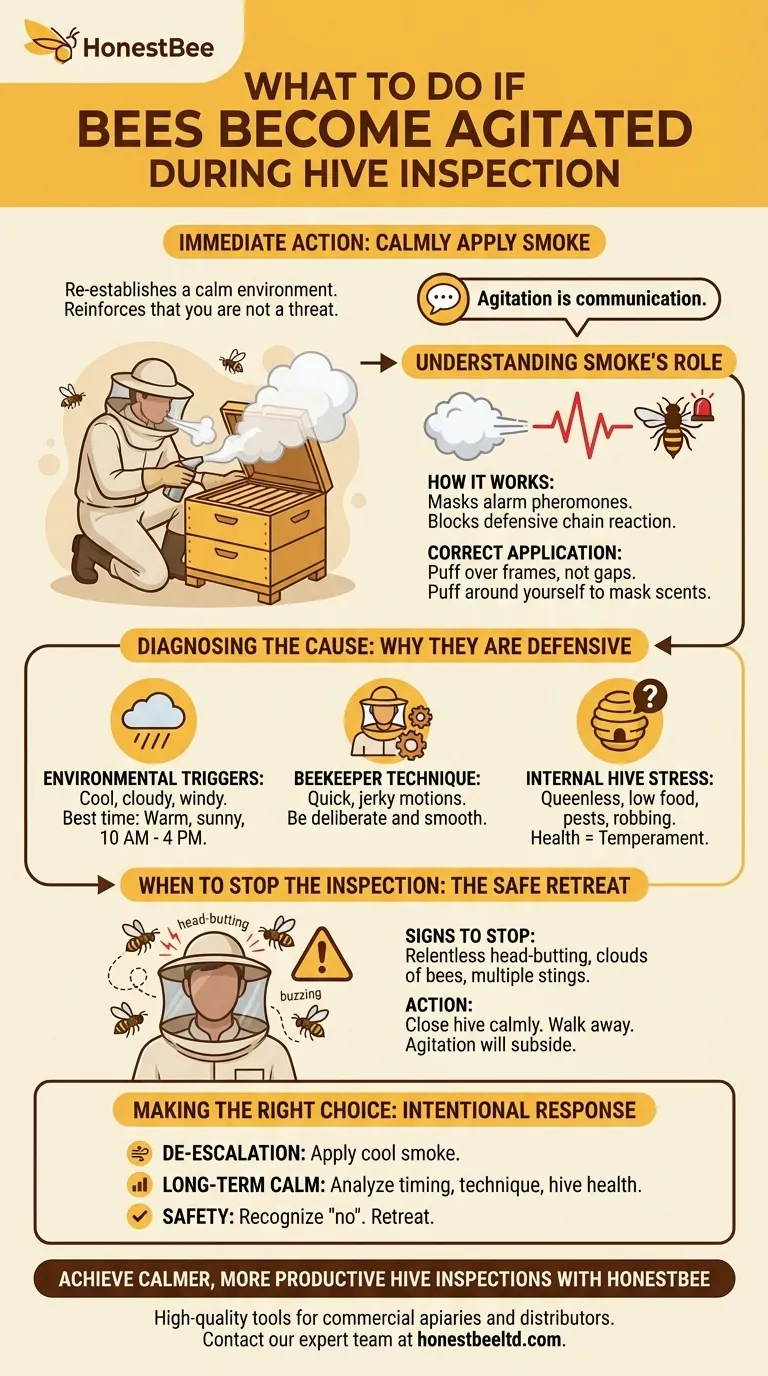When bees become agitated during an inspection, your immediate action is to calmly apply more smoke. Puff the smoke a few times over the top of the hive box you are working on and then direct a few puffs around yourself. This re-establishes a calm environment and reinforces to the bees that you are not a threat.
The key is to understand that agitation is a form of communication from the bees. While smoke is your primary tool for immediate de-escalation, your ultimate goal is to understand and address the root cause of their stress.

Understanding Smoke's Role
Smoke is not a magical sedative; it's a tool that interrupts the bees' primary communication and defense systems. Using it correctly is fundamental to a calm inspection.
How Smoke Actually Works
Smoke masks the bees' alarm pheromone. When a bee feels threatened or stings, it releases this pheromone, which smells like bananas and signals to other bees in the colony to become defensive and attack.
By introducing smoke, you effectively block this signal from spreading. This prevents a chain reaction of aggression and allows you to continue your work.
The Correct Application
The goal is calm, controlled application. Puff smoke over the top of the frames you are working on, not directly down into the gaps between them.
Puffing smoke around yourself, as mentioned in the references, helps mask any alarm pheromones that may have gotten on your suit or gloves. It encourages the bees to keep their distance.
Diagnosing the Cause of Agitation
If you find yourself constantly battling agitated bees, smoke is only a temporary fix. You must become a diagnostician and figure out why they are defensive.
Environmental Triggers
Bees are highly sensitive to their environment. Inspecting on a cool, cloudy, or windy day often leads to agitation, as more bees are at home and unable to forage.
The ideal time for an inspection is a warm, sunny, and calm day, typically between 10 AM and 4 PM, when a large portion of the foragers are out of the hive.
Beekeeper Technique
Your own movements are a primary factor. Quick, jerky motions or dropping a frame can be perceived as a threat from a large predator.
Work deliberately and smoothly. Give the bees a moment to adjust after you apply smoke and before you lift the first frame. Your goal is to be a part of the landscape, not an intruder.
Internal Hive Stress
A colony's temperament is a direct reflection of its health. A queenless hive, a hive low on food stores, or one experiencing pest pressure will be significantly more defensive.
Furthermore, if a hive is being "robbed" by bees from other colonies, its inhabitants will be on high alert. This is why practices like reducing the entrance for weaker hives are so critical—they prevent a major source of stress.
When to Stop the Inspection
A trusted advisor's most important lesson is knowing when to retreat. Pushing through a highly agitated inspection is dangerous for you and needlessly stressful for the bees.
Reading the Final Signs
If bees are relentlessly "head-butting" your veil, following you in a cloud, or if you receive multiple stings through your suit, the situation has escalated too far. At this point, more smoke is unlikely to calm the hive.
The Safe Retreat
Do not rush. Your goal is to close the hive as calmly and quickly as possible. Replace the frames in order, place the inner and outer covers back on, and walk away from the apiary. The bees' agitation will subside once you are gone.
Making the Right Choice for Your Goal
Your response to agitation should be intentional and based on the situation.
- If your primary focus is immediate de-escalation: Apply cool, white smoke across the top of the frames and around your body to interrupt their alarm signals.
- If your primary focus is long-term calm: Analyze your timing, your movements, and the overall health of the hive to address the root cause of the stress.
- If your primary focus is safety: Learn to recognize when the bees are telling you "no" and be prepared to close the hive and retreat for the day.
Ultimately, a successful beekeeper learns to read the hive's signals and works with the bees, not against them.
Summary Table:
| Action | Purpose | Key Insight |
|---|---|---|
| Apply Smoke | Immediate de-escalation | Masks alarm pheromones to prevent a defensive chain reaction. |
| Diagnose Cause | Long-term solution | Identify triggers like weather, technique, or hive health issues. |
| Retreat Safely | Ensure safety | Close the hive calmly if bees are head-butting or stinging relentlessly. |
Achieve Calmer, More Productive Hive Inspections with HONESTBEE
Constantly battling agitated bees can be stressful and unproductive. At HONESTBEE, we supply commercial apiaries and beekeeping equipment distributors with the high-quality, reliable tools needed for effective hive management. From premium bee smokers to essential protective gear, our wholesale-focused operations ensure you have the right equipment to work confidently and safely.
Let us help you build a more harmonious relationship with your hives. Contact our expert team today to discuss your specific needs and discover how our supplies can support the health of your operation.
Visual Guide

Related Products
- 54-Piece Smoker Fuel Pellets for Beekeeping Beehive Smoker Fuel
- Premium Traditional Copper Bee Smoker with Bellows
- Economy Galvanized Beekeeping Honey Bee Smoker for Wholesale
- European Stainless Steel Bee Smoker for Honey Bee Hive
- Stainless Steel Honey Bee Smoker Hive and Honeycomb Smoker for Beekeeping
People Also Ask
- How should you start the fire in a bee smoker? A Step-by-Step Guide for a Calm Hive
- What is the importance of fuel in a bee smoker? Ensure Cool, Calming Smoke for Your Hive
- What are important considerations when choosing smoker fuel? A Guide to Safe, Effective Beekeeping
- What is the best bee hive smoker fuel? Choose Natural, Slow-Burning Fuel for Calm Bees
- What is used in a bee smoker? Master the Best Fuels for Calm, Healthy Hives



















